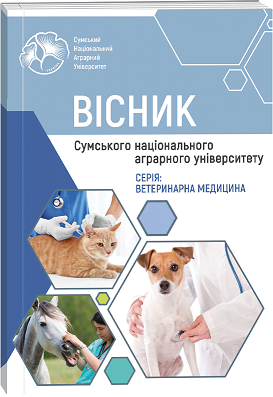SOFTWARE INFORMATION AND EXPERT SYSTEM AS A DIGITAL SOLUTION FOR OPTIMIZING THE RESULTS OF THE SECTIONAL EXAMINATION OF ANIMAL CARCASSES
Abstract
In order to successfully achieve the main goal of forensic expert activity (obtaining objective, substantiated, truthful, correct conclusions based on the results of research), digitalization and the direction of information technology development are the most promising. When creating an information expert system, it is taken into account that no cybernetic method will be able to cover the entire possible complex of solving expert tasks with its various objects, complex morpho-functional relationships between them and a significant variety of methods of their implementation. The platform for which the software was developed is Windows 7×32 or later versions with a more powerful processor. The Microsoft product Visual Studio 2019 was also used as a development environment, developed using WPF, which is part of the .Net platform system and is a subsystem for building graphical interfaces, whose reproduction is responsible for Direct X with the declarative interface markup language XAML and C#. The developed software complex "SVS – forensic-veterinary section" provides optimization and automation of forensic research; reducing the time spent on their implementation, increasing the productivity of experts; minimization of costs of material resources; formalization of forensic methods; obtaining reliable results; reliability of accumulation, processing of input data and transfer of processed research results to obtain new quality information (information product); algorithmization of expert operations. The signs of the examined animal corpse analyzed and marked by the forensic expert and recorded in the database of the proposed information and expert system are used during the preparation of the protocol part of the forensic veterinary autopsy of the animal corpse, and later – in the expert's opinion.
References
2. Ancheta, K., Le Calvez, S., & Williams, J. (2024). The digital revolution in veterinary pathology. Journal of Comparative Pathology, 214, 19-31. doi: 10.1016/j.jcpa.2024.08.001
3. Bertram, C. A., & Klopfleisch, R. (2017). The Pathologist 2.0: An Update on Digital Pathology in Veterinary Medicine, Veterinary Pathology, 54(5), 756-766. doi: 10.1177/0300985817709888
4. Bertram, C. A., Stathonikos, N., Donovan, T. A., Bartel, A., Fuchs-Baumgartinger, A., Lipnik, K., van Diest, P.J., Bonsembiante, F., & Klopfleisch, R. (2022). Validation of digital microscopy: Review of validation methods and sources of bias. Veterinary Pathology, 59(1), 26-38. doi: 10.1177/03009858211040476
5. Brogdon, R. (2024). Traditional Marketing Is Not Dead in Veterinary Practice. Veterinary Clinics of North America: Small Animal Practice, 54(2), 369-379. doi: 10.1016/j.cvsm.2023.10.004
6. Brühschwein, A., Klever, J., Hoffmann, A. S., Huber, D., Kaufmann, E., Reese, S., Meyer-Lindenberg, A. (2020). Free DICOM-Viewers for Veterinary Medicine: Survey and Comparison of Functionality and User-Friendliness of Medical Imaging PACS-DICOM-Viewer Freeware for Specific Use in Veterinary Medicine Practices. Journal of Digital Imaging, 33(1):54-63. doi: 10.1007/s10278-019-00194-3
7. Burti, S., Banzato, T., Coghlan, S., Wodzinski, M, Bendazzoli M, & Zotti A. (2024). Artificial intelligence in veterinary diagnostic imaging: Perspectives and limitations. Research in Veterinary Science, 175, 105317. doi: 10.1016/j.rvsc.2024.105317
8. Folgmann, M. S., Kleinsorgen, C., Stock, K. F., Meister, D., Hellige, M., Feige, K., & Delling, U. (2024). Digitalisation in pre-purchase examination and prospects for an equine health database in Germany-Results of an online survey among equine veterinarians. Equine Veterinary Journal, 56(5), 1050-1058. doi: 10.1111/evj.14001
9. Giacomazzo, M., Cian, F., Castagnaro, M., Gelain, M. E., & Bonsembiante, F. (2024). Digital Cytology in Veterinary Education: A Comprehensive Survey of Its Application and Perception among Undergraduate and Postgraduate Students. Animals (Basel), 14(11), 1561. doi: 10.3390/ani14111561
10. Grela, M., Panasiuk-Flak, K., Listos, P., Gryzińska, M., Buszewicz, G., Chagowski, W., & Teresiński, G. (2021). Post-mortem analysis of gunshot wounds to the head and thorax in dogs by computed tomography, radiography and forensic necropsy. Medicine, Science and the Law, 61(2), 105-113. doi: 10.1177/0025802420971176
11. Hanna, M. G., & Pantanowitz, L. (2019). Feasibility of using the Omnyx digital pathology system for cytology practice. Journal of the American Society of Cytopathology, 8(4), 182-189. doi: 10.1016/j.jasc.2019.01.003
12. Jones-Hall, Y. L., Skelton, J. M., & Adams, L. G. (2022). Implementing Digital Pathology into Veterinary Acade mics and Research. Journal of Veterinary Medicine, 49(5), 547-555. doi: 10.3138/jvme-2021-0068
13. Kalochristianakis, M., Kontogiannis, A., Flouri, D. E., Nathena, D., Kanaki, K., & Kranioti, E. F. (2024). IPPASOS: The first digital forensic information system in Greece. Health Information Management Journal, 53(2), 137-144. doi: 10.1177/18333583221144664
14. Kumar Basak, S., Wotto, M., & Bélanger, P. (2018). E-learning, M-learning and D-learning: Conceptual definition and comparative analysis. E-Learning and Digital Media, 15(4), 191-216. https://doi.org/10.1177/2042753018785180
15. Kummer, N., Delémont, O., Voisard, R., & Weyermann, C. (2022). The potential of digital technologies in problembased forensic learning activities. Science & Justice, 62(6), 740-748. doi: 10.1016/j.scijus.2022.04.005
16. Magalhães, G., Calisto, R., Freire, C., Silva, R., Montezuma, D., Canberk, S., & Schmitt, F. (2024). Invisible for a few but essential for many: the role of Histotechnologists in the establishment of digital pathology. Journal of Histotechnology, 47(1), 39-52. doi: 10.1080/01478885.2023.2268297
17. Marks, N. (2024). The Progressive Veterinary Practice. Veterinary Clinics of North America: Small Animal Practice, 54(2):265-276. doi: 10.1016/j.cvsm.2023.10.011
18. Piccione, J., & Baker, K. (2023). Digital Cytology. Veterinary Clinics of North America: Small Animal Practice, 53(1), 73-87. doi: 10.1016/j.cvsm.2022.07.007
19. Rogers, L., Galezowski, A., Ganshorn, H., Goldsmith, D., Legge, C., Waine, K., Zachar, E., & Davies, J. L. (2024). The use of telepathology in veterinary medicine: a scoping review. Journal of Veterinary Diagnostic Investigation, 36(4), 490-497. doi: 10.1177/10406387241241270
20. Yamada, K., Satoh, K., Kanai, E., & Madarame, H. (2023). Role of autopsy imaging in veterinary forensic medicine: experiences in 39 cases. Journal of Veterinary Medicine Science, 85(3), 301-307. doi: 10.1292/jvms.22-0548
21. Yatsenko, I. V. (2008). Metodolohiya stvorennya ta vykorystannya osteolohichnykh kompʺyuternykh tekhnolohiy pry doslidzhenni biolohichnoho materialu v sudovo-veterynarniy ekspertyzi [Methodology for creating and cutting out osteological components of technological equipment when reaching biological material in forensic veterinary examination]. Visnyk Derzhavnoho ahroekolohichnoho universytetu, 1(21), 211-219 (in Ukrainian)
22. Zuraw, A., & Aeffner, F. (2022). Whole-slide imaging, tissue image analysis, and artificial intelligence in veterinary pathology: An updated introduction and review. Veterinary Pathology, 59(1), 6-25. doi: 10.1177/03009858211040484

 ISSN
ISSN  ISSN
ISSN 



